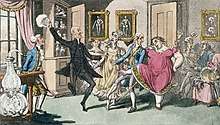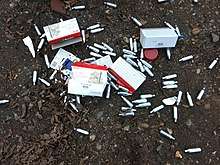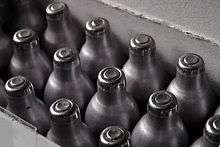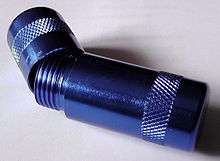Recreational use of nitrous oxide
Nitrous oxide gas produces euphoriant effects when inhaled. First recorded in the 18th century at upper-class "laughing gas parties", the experience was largely constrained to medical students until the late 20th century when laws limiting access to the gas were loosened to supply dentists and hospitals. By the 2010s, nitrous oxide had become a moderately popular recreational drug in some countries. Possession of nitrous oxide is legal in many countries, although some have criminalised supplying it for recreational purposes.
Effects
Nitrous oxide is a dissociative inhalant that can cause analgesia, depersonalisation, derealisation, dizziness, euphoria, and some sound distortion (flanging).[1] In some cases, it may cause slight hallucinations and have a mild aphrodisiac effect.[2]
Research has also found that it increases suggestibility and imagination.[3]
History

Inhalation of nitrous oxide for recreational use, with the purpose of causing euphoria or slight hallucinations, began as a phenomenon for the British upper class in 1799, known as "laughing gas parties".[4] English chemist Humphry Davy offered the gas to party guests in a silken bag, and documented its effects in his 1800 book Researches, Chemical and Philosophical which investigated "nitrous oxide, or diphlogisticated nitrous air, and its respiration".[5] Poet Samuel Taylor Coleridge described the effect as "like returning from a walk in the snow into a warm room".[4]
During the 19th century, William James and many contemporaries found that inhalation of nitrous oxide resulted in a powerful spiritual and mystical experience for the user. James claimed to experience the fusing of dichotomies into unity and a revelation of ultimate truth during the inhalation of nitrous oxide. The memory of this experience, however, quickly faded and any attempt to communicate was difficult at best. James described a man who, when under the influence of the gas, claimed to know the secret of the universe.[6]
Until at least 1863, low availability of equipment to produce the gas, combined with low usage of the gas for medical purposes, meant it was a relatively rare phenomenon that mainly happened among students at medical universities. When equipment became more widely available for dentistry and hospitals, most countries also restricted the legal access to buy pure nitrous oxide gas cylinders to those sectors. Even so, its use in parties continued, with gas provided by medical professionals or restaurant workers,[7][8] and by other legal or illegal sources.
A report from Consumers Union report from 1972 (based upon reports of its use in Maryland 1971, Vancouver 1972, and a survey made by Edward J. Lynn of its non-medical use in Michigan 1970) found that use of the gas for recreational purposes was then prevalent in the US and Canada.[7][8]
It was not uncommon [in the interviews] to hear from individuals who had been to parties where a professional (doctor, nurse, scientist, inhalation therapist, researcher) had provided nitrous oxide. There also were those who work in restaurants who used the N
2O stored in tanks for the preparation of whip cream. Reports were received from people who used the gas contained in aerosol cans both of food and non-food products. At a recent rock festival, nitrous oxide was widely sold for 25 cents a balloon. Contact was made with a "mystical-religious" group that used the gas to accelerate arriving at their transcendental-meditative state of choice. Although a few, more sophisticated users employed nitrous oxide-oxygen mixes with elaborate equipment, most users used balloons or plastic bags. They either held a breath of N
2O or rebreathed the gas. There were no adverse effects reported in the more than one hundred individuals surveyed.[8]
Current status

As of 2019, the drug enjoys moderate popularity in some countries. In the United Kingdom, as of 2014, nitrous oxide is estimated to be used by almost half a million young people at nightspots, festivals and parties. Officials in Norfolk, Hertfordshire and Thames Valley had reported increasing numbers of discarded whipped-cream chargers being found.[9]
Methods of inhalation
Recreational users generally use 8 gram containers of nitrous oxide "whippets", which they use to fill balloons or whipped cream dispensers. The gas is then inhaled from the balloon or dispenser.[10] This is necessary because nitrous oxide is very cold when it undergoes adiabatic decompression on exit from a canister; inhalation directly from a tank is dangerous and can cause frostbite of the larynx. Some users attach gas masks or other inhalation devices to large tanks of the gas.
In Australia, nitrous oxide bulbs are known as "nangs", possibly derived from the sound distortion perceived by consumers.[11][12]
Health concerns
Since nitrous oxide can cause dizziness, dissociation, and temporary loss of motor control, it is unsafe to inhale while standing up. Inhalation directly from a tank poses serious health risks, as it can cause frostbite since the gas is very cold when released. For those reasons, most recreational users will discharge the gas into a balloon or whipped cream dispenser before inhaling.
Nitrous oxide can be habit-forming, mainly because of its short-lived effect (generally from 1–5 minutes in recreational doses) and ease of access. Death can result if it is inhaled in such a way that not enough oxygen is breathed in. While the pure gas is not toxic, long-term use has been associated with vitamin B12 deficiency and its symptoms: anemia due to reduced hemopoiesis, neuropathy, tinnitus, and numbness in extremities. Pregnant women should not use nitrous oxide recreationally, because chronic use is also teratogenic and foetotoxic.
Inhaling industrial-grade nitrous oxide is also dangerous, as it contains many impurities and is not intended for use on humans. Food grade nitrous oxide is also not meant to be inhaled; the bulbs commonly have industrial lubricants from their manufacturing process on and in them. When the bulb is punctured, these solvents can aerosolize, introducing unknown particles into the gas. These lubricants commonly leave an oily residue on the bulb "cracker" or inside the whipped cream dispenser.[13] However, letting the gas settle in a whip cream container and slowly dispensing or using a "cracker" dispensed into a balloon mitigates this issue to some extent.
Nitrous oxide related deaths
Deaths linked to nitrous oxide are rare, but do happen when done incorrectly or overused. Few nitrous oxide related deaths where nitrous oxide was mentioned on the death certificate were reported in the UK until the early 2000s; starting around 2010 deaths rose to around 5–10 per year.[14]
In 2018, an Ohio University freshman died of asphyxiation as a result of nitrous oxide ingestion from whipped-cream chargers, allegedly as part of a hazing ritual.[15]
In 2020, a fifteen-year-old Irish boy died after ingesting nitrous oxide,[16] leading to Ireland's Health Service Executive classing it as a dangerous drug.[17]
Legality
United States
Under United States federal law, possession of nitrous oxide is legal and is not subject to DEA purview. It is, however, regulated by the Food and Drug Administration under the Food Drug and Cosmetics Act. Prosecution is possible under its "misbranding" clauses, prohibiting the sale or distribution of nitrous oxide for the purpose of human consumption (the recreational drug use market). Given the necessity of proving the intent of either buyer or seller in this case, though, such prosecutions are rare.
Many states have laws regulating the possession, sale, and distribution of nitrous oxide; but these are normally limited to either banning distribution to minors, or to setting an upper limit for the amount of nitrous oxide that may be sold without a special license, rather than banning possession or distribution completely. In most jurisdictions, like at the federal level, sale or distribution for the purpose of human consumption is illegal. In California, for instance, inhalation of nitrous oxide "for the purpose of causing euphoria, or for the purpose of changing in any manner one’s mental processes," is a criminal offense under its criminal code (Cal. Pen. Code, Sec. 381b). In many other countries, this substance is legal. Small N2O cartridges, used to make whipped cream, can be legally purchased by anyone.
In all US jurisdictions, however, distribution, possession, and inhalation are legal when done under the supervision and direction of licensed medical professional such as a physician or dentist. Other countries like Germany, The Netherlands and Belgium also legalized it.
United Kingdom
Nitrous oxide canisters made for the purpose of prolonging the shelf life of whipped cream and other products are completely legal and readily available. Anyone can buy these without a permit.[18]
Supply of nitrous oxide for recreational purposes is illegal under the Psychoactive Substances Act 2016. This means anyone found to be selling or giving away nitrous oxide for illicit purposes could face up to 7 years in prison and or an unlimited fine.[19]
Words used to describe canisters in the United Kingdom include:
- Balloons
- Nos
- Whippits
- Laughing Gas
- Hippie Crack
- Chargers
- Loons
- Noz[20]
Australia
Supply of nitrous oxide for recreational purposes is illegal, however, it is permissible to supply it for cooking and baking purposes. As a deleterious substance, the supply of the substance for the purposes of inhalation can result in a 2-year period of imprisonment.[21]
The substance is commonly referred to in Australia as "nang" or "Johnson". [22]
Netherlands
Usage of nitrous oxide is currently still legal, although the governing coalition is attempting to add the gas to the list of drugs prohibited by the Opium Law.[23][24] On the 12th of June 2020, the proposal to add nitrous oxide to List II of the Opium Law was brought into online consultation, allowing the public to contribute "ideas or suggestions" relating to the ban. The government aims to bring the proposed ban into force on the 1st of January 2021.[25] In anticipation of the proposed ban coming into law, around 90 municipalities have introduced local bans of the substance.[26]
See also
- Dissociatives
- Inhalant
- Psychoactive drug
References
- Giannini, A. J. (1991). Miller, N. S. (ed.). Volatiles. New York: Marcel Dekker. p. 396. ISBN 0-8247-8474-X.
- Gillman, Mark A.; Lichtigfeld, Frederick J. (1983). "The effects of nitrous oxide and naloxone on orgasm in human females: A preliminary report". Journal of Sex Research. 19 (1): 49–57. doi:10.1080/00224498309551168.
- Whalley MG, Brooks GB; Brooks (2009). "Enhancement of suggestibility and imaginative ability with nitrous oxide". Psychopharmacology. 203 (4): 745–52. doi:10.1007/s00213-008-1424-0. PMID 19057896.
- Kelsey-Sugg, Anna (19 February 2019). "When people partied with nitrous oxide, it sparked a medical breakthrough". www.abc.net.au. Retrieved 6 July 2020.
- Davy, Humphry (1800). Researches, chemical and philosophical : chiefly concerning nitrous oxide, or diphlogisticated nitrous air, and its respiration. London : printed for J. Johnson, St. Paul's Church-Yard, by Biggs and Cottle, Bristol.
- James, William (1882), The Subjective Effects of Nitrous Oxide, retrieved 27 November 2015
- Brecher EM (1972). "Consumers Union Report on Licit and Illicit Drugs, Part VI – Inhalants and Solvents and Glue-Sniffing". Consumer Reports Magazine. Retrieved 18 December 2013.
- Lynn, Edward J.; Walter, Richard G.; Harris, Lance A.; Dendy, Robert; James, Mary (1972). "Nitrous Oxide: It's a Gas" (PDF). Journal of Psychoactive Drugs. Journal of Psychedelic Drugs. 5: 1–7. doi:10.1080/02791072.1972.10471462.
- "Warning over laughing gas misuse". The Guardian. 9 August 2014.
- Garland EL, Howard MO, Perron BE (December 2009). "Nitrous oxide inhalation among adolescents: prevalence, correlates, and co-occurrence with volatile solvent inhalation". J Psychoactive Drugs. 41 (4): 337–47. doi:10.1080/02791072.2009.10399771. PMC 2921531. PMID 20235440.
- Emory, Sami (1 March 2017). "Will Nangs Kill You?". Vice.
- "'Nanging' out: the rise of nitrous oxide as a Sydney party drug". The Sydney Morning Herald.
- Erowid F, Erowid E. "N2Oily: Nitrous Oxide Chargers—Residue and Usage Surveys." Erowid Extracts. Nov 2009;17:12–14.
- "Drug-related deaths involving nitrous oxide, 1993 to 2016". Office for National Statistics. 28 September 2017. Retrieved 14 February 2019.
- CNN, Dakin Andone and Carma Hassan. "Family files lawsuit in death of fraternity pledge at Ohio University". CNN. Retrieved 10 November 2019.
- "'Just say no' - heartbroken father whose son died from laughing gas warns others to stay away from 'lethal' drug". independent. Retrieved 10 July 2020.
- Gleeson, Colin (8 July 2020). "Minister seeks report on use of laughing gas following death of a teenager". The Irish Times. Retrieved 10 July 2020.
- Participation, Expert. "Psychoactive Substances Act 2016". www.legislation.gov.uk. Retrieved 2019-02-14.
- "The Law : Psychoactive Substances". Talk to Frank. 14 February 2019. Retrieved 14 February 2019.
- "Nitrous Oxide – A colourless gas that people inhale, usually via a balloon". Talk to Frank. Retrieved 14 February 2019.
- "Are nangs actually legal?". Leave Law to Criminals. 16 February 2019. Retrieved 16 February 2019.
- "'It's flat-out stupid': Warnings on the dangerous rise in use of 'nangs'". www.abc.net.au. October 16, 2017.
- . DutchNews. 12 June 2020 https://www.dutchnews.nl/news/2020/06/no-laughing-matter-new-legislation-will-ban-the-sale-of-nitrous-oxide/. Retrieved 14 June 2020. Missing or empty
|title=(help) - "Lachgas op de lijst van de opiumwet". Nederlandse Omroep Stichting (in Dutch). 9 December 2019.
- Ministerie van Volksgezondheid, Welzijn en Sport (2020-06-12). "Wetsvoorstel lachgasverbod maakt einde aan lachgas in gasflessen voor consumenten - Nieuwsbericht - Rijksoverheid.nl". www.rijksoverheid.nl (in Dutch). Retrieved 2020-07-22.
- "Zo'n 90 gemeenten lopen vooruit op verbod op lachgas, nemen zelf maatregelen". nos.nl (in Dutch). Retrieved 2020-07-22.

